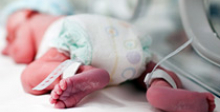Internal mini form
Contact Us Today
Intrauterine growth restriction, IUGR, is defined as a fetus with a weight that falls below the 10th percentile and abdominal circumference below the 2.5th percentile when compared to others of the same gestational period. Learn how IUGR occurs.
What is intrauterine growth restriction?
Intrauterine growth restriction is defined as a fetus with a weight that falls below the 10th percentile and abdominal circumference below the 2.5th percentile when compared to others of the same gestational period.
Reasons for IUGR can include:
- chromosomal abnormalities
- drug and alcohol abuse
- heart disease in mother
- maternal high blood pressure or heart disease
- poor nutrition
- preeclampsia or eclampsia
- placenta problems
- parental risk factors such as smoking
IUGR is a risk factor for Cerebral Palsy and a leading cause of perinatal mortality and morbidity. The risk is highest in preterm children, and minimal in very preterm and full-term deliveries.
Much like low birth weight, small size alone does not equal IUGR. Many babies are born small and healthy. A true IUGR diagnosis can only be made after a careful exam of the newborn. Therefore, it is very important to monitor fetal size and weight throughout pregnancy to be aware of the possibility.
Were you or your child at risk – before, during or after your child’s birth?
Cerebral Palsy risk factors are events, substances or circumstances that increase the chances of a child developing Cerebral Palsy. They can be avoidable, or unavoidable. A risk factor does not ensure a child will develop Cerebral Palsy; it means chances are higher than if that risk factor was not present. Likewise, the absence of risk factors does not ensure that a child will not develop Cerebral Palsy. Have you been exposed to the following risk factors?
- Cerebral Palsy Risk Factors
Types of risk factors:
- Asphyxia and oxygen deprivation
- Blood type incompatibility or jaundice
- Complications of birth
- Infection
- Intrauterine growth restrictions
- Multiple births and infertility drugs
- Parental health and habits
- Placenta complications
- Premature birth
- Traumatic brain damage
Risk factors vs. risk factor causal pathways
A risk factor does not ensure a child will develop Cerebral Palsy; it means chances are higher than if that risk factor was not present. Likewise, the absence of risk factors does not ensure that a child will not develop Cerebral Palsy.
- Risk Factors and Risk Factor Causal Pathways
The Cerebral Palsy Risk Factor Checklist
Any exposure to risk factors prior to conception and during pregnancy should be immediately discussed with a doctor in order to treat and minimize risk. The Cerebral Palsy Risk Factor Checklist helps parents determine if they may have been exposed to risk factors for Cerebral Palsy.
- The Cerebral Palsy Risk Factor Checklist









